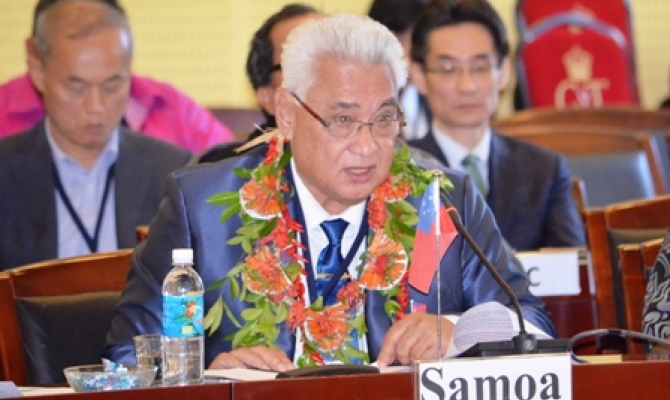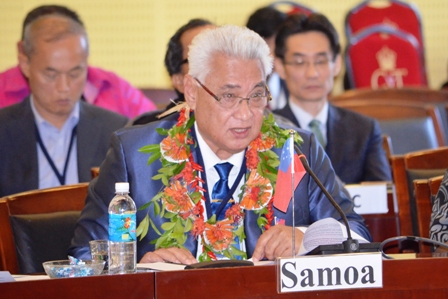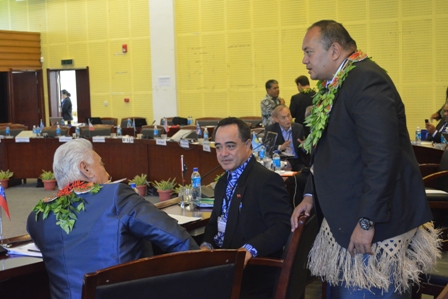
Climate Change Resilience
Ms. Faumuina Felolini Tafuna’I writing for the Samoa Observer
July, 2015, Nuku’alofa, Tonga – Samoa’s call for a regional weather and climate declaration to include international frameworks on sustainable development has been answered.
Specifically, Samoa wanted the post-2015 Sustainable Development Goals (SDGs) included in the Nuku’alofa Ministerial Declaration for Sustainable Weather and Climate Services for a Resilient Pacific.
Regional meteorology Government ministers and representatives are in Tonga for the first Pacific Ministerial Meeting on Meteorology and adopted the declaration.
 Samoa’s Minister of Natural Resources and Environment, Faamoetauloa Lealaiauloto Taito Dr Faale Tumaalii
Samoa’s Minister of Natural Resources and Environment, Faamoetauloa Lealaiauloto Taito Dr Faale TumaaliiSamoa’s Minister of Natural Resources and Environment, Faamoetauloa Lealaiauloto Taito Dr Faale Tumaalii, made the request during his country statement. “We can’t just talk about sustainable development we must connect our goals to this international framework.”
The SDGs were finalised in March and are due to be adopted in September in New York. They replace the Millennium Development Goals, which will finish at the end of the year.
There are 17 SDG goals that include ending poverty and hunger, achieving gender empowerment, access to health, education, environmental sustainability and taking urgent action on climate change and revitalising global partnerships for sustainable development.
Faamoetauloa describe the SDGs as the cornerstone that will “guide every country in implementing their development goals”.
Samoa’s request to include the SDGs was also supported by Papua New Guinea’s Department of Transport and Infrastructure Secretary Roy Mumu, who said weather services were critical to his country’s development.
The other frameworks included in the declaration include the SAMOA Pathway, the Sendai Framework on Disaster Risk Reduction, and the outcomes of the 21st Conference of the Parties of United Nations Framework Convention on Climate Change.
“From a positive angle, we should also look at how the Met service has contributed to the gross domestic product of a country,” said Faamoetauloa.
He said Samoa had programmes that connected climate to the agricultural, health and energy sector to build economic and environmental resilience.
During the meeting, World Meteorological Organisation’s, Resource Mobilisation Officer Director, Mary Power delivered a presentation on the socio-economic values of water and weather services.
Power said the World Bank estimates that better water and weather services will lead to USD30 billion a year in global productivity.
She said for every $1 spent on improving national water and weather services, there were reduced losses or costs of between $4 and $36.
Her presentation showed the economic benefits of improved Met services in the Pacific including a 1 per cent reduction in damage from improved warnings that generated regional cash savings of USD3.62 million.
Power ended her presentation re-stating a comment the Tonga Crown Prince His Royal Highness Tupuoto’a ‘Ulukalala made during the opening session: “Having a robust Weather Service is no longer a luxury for us but an obligation,” and added it was also a “human right”.
Faamoetauloa supported the findings saying if the communities were well prepared, there would be less damage from severe weather hazards and long-term climate effects.

Samoa in talks with Chair of the Pacific Ministerial Meteorological Meeting
He also called on the government ministers to meet annually, instead of every four years as scheduled. He said that the meetings needed to be timed so the issues could be taken up the Pacific Island Leaders Forum meeting and the annual Secretariat of the Pacific Regional Environment Programme meeting.
“Otherwise nothing will be done if it does not go up to the decision-making level.”
Faamoetauloa added that with the current frequency, there was the chance that with national elections, there would be a lack of continuity with attending ministers.
His request was supported by Tuvalu Minister of Communications and Transport Monise Lafai.
The Government Ministers moved to amend the schedule to meet every two years, which was a more affordable option for the region. -#PacMC2015
Ms. Faumuina Felolini Tafuna’I is a freelance journalist writing for the Samoa Observer - www.samoaobserver.ws
This article was developed by a Pacific Media Team of Reporters currently providing coverage on the Third Pacific Meteorological Council in Tonga. This activity coordinated by SPREP is supported by a partnership including the Government of Tonga, SPREP, Finland Ministry of Foreign Affairs, Finnish Meteorological Institute (FMI), World Meteorological Organization (WMO) and the Pacific Media Assistance Scheme (PACMAS).
This article was developed by a Pacific Media Team of Reporters currently providing coverage on the Third Pacific Meteorological Council in Tonga. This activity coordinated by SPREP is supported by a partnership including the Government of Tonga, SPREP, Finland Ministry of Foreign Affairs, Finnish Meteorological Institute (FMI), World Meteorological Organization (WMO) and the Pacific Media Assistance Scheme (PACMAS).